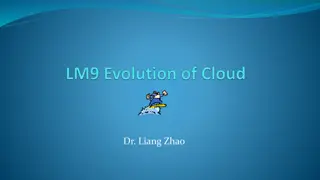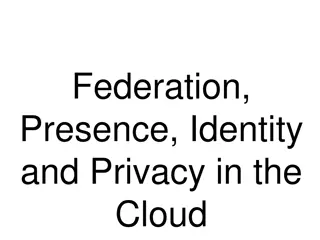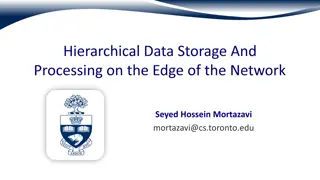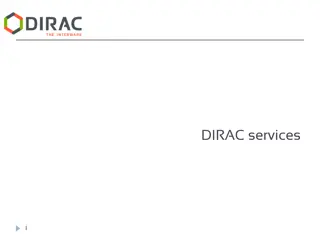Impact of Cloud Computing Technology on Young Firms' Performance
The technology shock of cloud computing has significantly influenced the survival and performance of young firms. Young firms face higher uncertainty, benefit from experimentation, and are resource-constrained, making cloud computing's elastic, fast, and generic nature particularly advantageous. This shift from traditional IT to cloud computing has economic implications for young firms, affecting their operations and competitiveness.
Download Presentation

Please find below an Image/Link to download the presentation.
The content on the website is provided AS IS for your information and personal use only. It may not be sold, licensed, or shared on other websites without obtaining consent from the author.If you encounter any issues during the download, it is possible that the publisher has removed the file from their server.
You are allowed to download the files provided on this website for personal or commercial use, subject to the condition that they are used lawfully. All files are the property of their respective owners.
The content on the website is provided AS IS for your information and personal use only. It may not be sold, licensed, or shared on other websites without obtaining consent from the author.
E N D
Presentation Transcript
Wang Jin, MIT Initiative on the Digital Economy Kristina McElheran, University of Toronto & IDE Technology and Declining Economic Dynamism September 11, 2020
Any opinions and conclusions expressed herein are those of the authors and do not necessarily represent the views of the U.S. Census Bureau. All results have been reviewed to ensure that no confidential information is disclosed.
Source: Haltiwanger, Jarmin, Kulick, & Miranda (2016) K. McElheran University of Toronto
K. McElheran University of Toronto
Cloud computing is a type of Internet-based computing that provides shared computer processing resources and data to computers and other devices on demand. which can be rapidly provisioned and released with minimal management effort. In 2009, the availability of high-capacity networks, low- cost computers and storage devices as well as [lots of technology jargon about containers and virtualization] led to a growth in cloud computing. K. McElheran University of Toronto
K. McElheran University of Toronto
IaaS (virtual machines) Storage Compute PaaS Compute + Operating system or other layer (e.g. SQL) Apps bundled with products SaaS Enterprise Resource Planning (ERP) Supply Chain Management Engineering (CAD/CAM) HR Etc. K. McElheran University of Toronto
Did the technology shock of cloud computing have an effect on the survival and performance of young firms? Why? K. McElheran University of Toronto
Young firms are different from old Face higher uncertainty (Schumpeter 1934; Knight 1957 ) Benefit from experimentation (Kerr et al. 2014; Nanda & Rhodes- Kropf 2016; Ewens et al. forth.) Resource-constrained(e.g., Attewell 1992) Cloud is different from traditional IT Elastic Fast Generic Implications for economic performance K. McElheran University of Toronto
IT Services IT Capital Benefit Variable cost Control Rapid Customization Scalable Cost Loss of control High fixed cost Undifferentiated Irreversible (Higher cost per unit) Rapid depreciation K. McElheran University of Toronto
Experimentation is important for learning in the face of uncertainty (Nanda & Rhodes-Kropf 2012, 2013, 2016; Kerr et al. 2014; Ewens, Nanda, & Rhodes-Kropf forthcoming.) Cloud computing lowers the costs of experimentation (Ewens et al. forthcoming) particularly when it comes to determining IT needs Young firms face systematically high uncertainty (Schumpeter 1934; Knight 1957; Jovanovic 1982; Dixit & Pindyck 1994; Foster, et al. 2016) UPSHOT: This new, flexible platform for accessing IT services may ease constraints for the most dynamic and most vulnerable firms K. McElheran University of Toronto
US Census & Annual Survey of Manufactures IT capital investments from 2002 Expenditure on IT Services, Software, and Equipment 2006-2014 >230,000 establishment-year observations From 1stemployee to >40 years old (18% are young ) ~70% of Manufacturing economy in certainty sample K. McElheran University of Toronto
K. McElheran University of Toronto
Associated with better survival, growth, and productivity of young plants young + small benefit the most old + small still rely on owned IT older + big are a puzzle (follow-on paper) K. McElheran University of Toronto
(5) (1) All (2) All (2) (3) (4) Models Older w/ F.E Young only Older only Young w/ F.E. 0.001** (0.0007) 0.003** (0.001) 0.0002 (0.001) 0.004** (0.002) 0.007*** (0.002) -0.003 (0.001) 0.009*** (0.003) IT services 0.013*** (0.001) 0.015*** (0.002) 0.012*** (0.002) 0.012*** (0.001) 0.007** (0.004) IT capital stock -0.0003** (0.0001) -0.009** (0.001)* Age -0.001** (0.001) Age x IT Services Industry x Year F.E. Y Y Y Y N N Plant & Year F.E. N N N N Y Y # Plants per year ~26,600 ~26,600 ~4,600 ~22,000 ~4,600 ~22,000 # Years 9 9 9 9 9 9 K. McElheran University of Toronto
K. McElheran University of Toronto
IT-Intensive Industries (2005) 0.012*** (0.003) 0.0002 (0.003) 0.038*** (0.012) 0.009** (0.004) High Variance Industries (Young) 0.019*** (0.003) 0.002 (0.003) High Variance Industries (Old) 0.016*** (0.004) 0.007*** (0.003) Models IT capital stock IT services IT intensive IT services x IT intensive 0.007 (0.011) -0.021*** (0.006) High variance 0.006*** (0.001) 0.012*** (o.oo4) IT services x High Variance K. McElheran University of Toronto
Young benefit more than old from IT as a service. True for young establishments inside older firms Mechanisms with consistent support are benefits form flexibility and reduced costs of experimentation when uncertainty is high. Productivity and dynamism may be changing in the wake of this technology shock. K. McElheran University of Toronto
K. McElheran University of Toronto
K. McElheran University of Toronto























